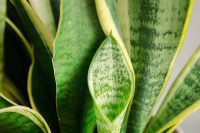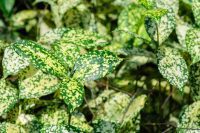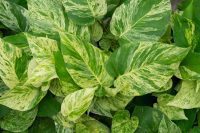Is snake plant toxic to dogs?
Snake plant (Dracaena trifasciata) is toxic to dogs. The toxic principle is saponins, which are surface-active glycosides with a foamy quantity, hence the name. Ingestion is associated with gastrointestinal disturbances including vomiting and diarrhea.
What is snake plant?
- Family: Asparagaceae
- Scientific name: Dracaena trifasciata (formerly Sansevieria trifasciata)
- Common names: St George’s sword, Snake plant, Snake tongue, Mother-in-laws tongue, Viper’s bowstring hemp, Bowstring hemp, Jinn’s tongue, Devil’s tongue, Golden bird’s nest
- Plant type: Succulent
- Toxic parts: All parts of the plant are toxic to dogs
- Toxicity: Mild
- Toxic principle: Saponins

Snake plant (Dracaena trifasciata) is an attractive succulent native to tropical regions of West Africa. It is commonly grown as a houseplant or architectural plant and is popular for its sword-like leaves with bold striped patterns.
Snake plant is the perfect starter plant for novice gardeners, as it is extremely hardy, forgiving and almost impossible to kill. It is drought tolerant and will thrive in either a shady area or in full sun. Plants in full sun will grow faster than those in part or full shade. The biggest risk to snake plant is over-watering, leading to root rot.
Propagation of snake plant is easy. The roots produce rhizomes from which new snake plant leaves emerge. These can be broken away from the mother plant and re-potted.
There are over 60 snake plant cultivars which include:
- ‘Futura Robusta’
- ‘Bantel’s Sensation’
- ‘Hahnii’
- ‘Silver Flame’
- ‘Black Gold’
- ‘Futura Superba’
- ‘Golden Hahnii’
- ‘Golden Flame’
- ‘Cylindrica’
- ‘Black Robusta’
- ‘Black Jack’
A 1989 NASA study found that snake plant can release oxygen while absorbing carbon dioxide, increasing the concentration of ions in indoor air.
Toxicity
The University of California has placed snake plant in the toxicity class of 2 and 4.
2. Minor Toxicity: Ingestion of these plants may cause minor illnesses such as vomiting or diarrhea. If ingested, call the Poison Control Center or your doctor.
4. Dermatitis: The juice, sap, or thorns of these plants may cause a skin rash or irritation. Wash the affected area of skin with soap and water as soon as possible after contact. The rashes may be very serious and painful. Call the Poison Control Center or your doctor if symptoms appear following contact with the plants.
It is widely claimed that ingestion of snake plant can cause blood cells to rupture and die (hemolysis). However, there is no verified research or data to back up this claim and no mention of this on the ASPCA, Pet Poison Helpline or the University of California.
Clinical signs
Symptoms of snake plant ingestion may vary depending on the amount of plant consumed, and the overall health of the dog. The most common symptoms relate to gastrointestinal disturbances and may include:
- Lethargy
- Drooling
- Nausea
- Loss of appetite
- Vomiting
- Diarrhea
First aid
Carefully remove any remaining plant matter from the dog’s mouth to prevent any further ingestion. Contact a veterinarian if the dog develops clinical signs associated with saponin toxicity.
Treatment
Most cases of snake plant ingestion are self-limiting and don’t require veterinary attention. For dogs who have developed moderate gastrointestinal signs the following treatment options may be necessary.
For dogs who have not vomited, the veterinarian will induce vomiting to remove any plant matter from the gastrointestinal tract. This may be followed up with activated charcoal which will bind to any remaining plant matter.
Intravenous fluids will be administered to dogs with vomiting and/or diarrhea to prevent or treat dehydration and electrolyte derangements.
Additional therapies may include antiemetics for dogs with prolonged vomiting and gastric protectants.
The dog will be placed on a bland diet for a few days to rest the gastrointestinal tract.
Prognosis
The prognosis for dogs with snake plant ingestion is excellent.
Prevention
Most dogs won’t show any interest in snake plant, but some dogs (especially puppies) will chew anything. If you have a snake plant in the home or garden and your dog has attempted to consume some of the plants, it is safer to remove the temptation and relocate the plant to an area the dog can’t access or give it to a dog-free home. There are plenty of dog-safe plants for plant lovers, which includes spider plants, orchids, roses, ponytail palm, bird’s nest fern, parlour palm, bromeliads, hoya, pilea and polka dot plant. Most dogs will happily chew on cat grass.
Julia is a writer and landscape consultant from Wollongong with a love of horticulture. She had been an avid gardener for over 30 years, collects rare variegated plants and is a home orchardist. Julia is passionate about learning and sharing her knowledge of plant propagation and plant toxicology. Whether it’s giving advice on landscape projects or sharing tips on growing, Julia enjoys helping people make their gardens flourish.




